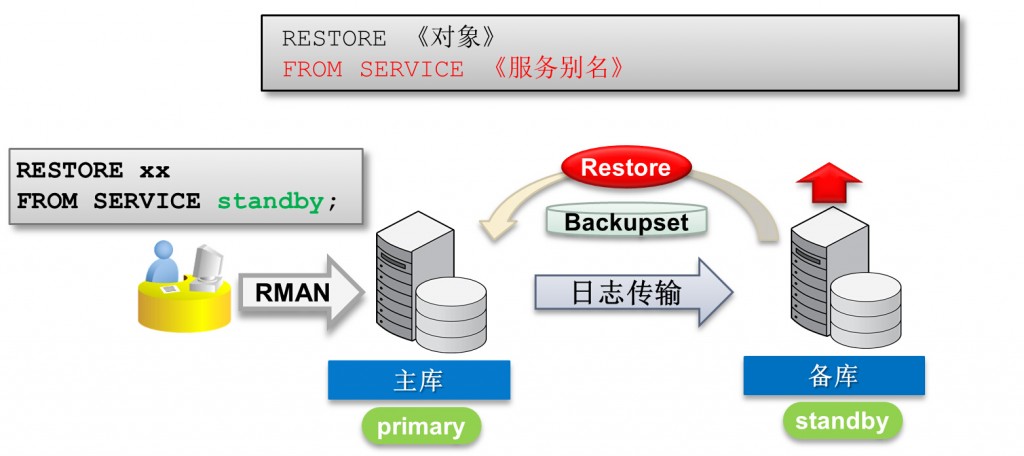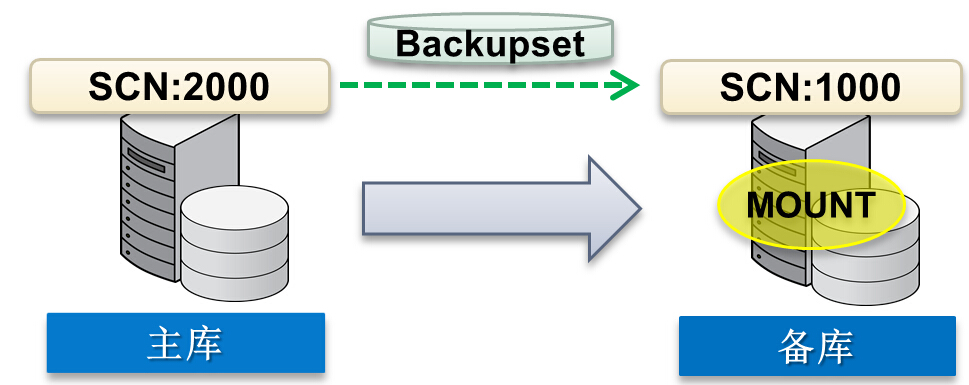12c中提供了基于网络的RMAN Restore和recover功能:
About Restoring Files Over the Network
RMAN restores database files, over the network, from a physical standby database by using the
FROM SERVICEclause of theRESTOREcommand. TheFROM SERVICEclause provides the service name of the physical standby database from which the files must be restored. During the restore operation, RMAN creates backup sets, on the physical standby database, of the files that need to be restored and then transfers these backup sets to the target database over the network.Use the
SECTION SIZEclause of theRESTOREcommand to perform a multisection restore operation. To encrypt the backup sets created on the physical standby database, use theSET ENCRYPTIONcommand before theRESTOREcommand to specify the encryption algorithm used.To transfer files from the physical standby database as compressed backup sets, use the
USING COMPRESSED BACKUPSETclause in theRESTOREcommand. By default, RMAN compresses backup sets using the algorithm that is set in the RMAN configuration. You can override the default and set a different algorithm by using theSET COMPRESSION ALGORITHMcommand before theRESTOREstatement.
About Recovering Files Over the Network
RMAN can perform recovery by fetching an incremental backup, over the network, from a primary database and then applying this incremental backup to the physical standby database. RMAN is connected as
TARGETto the physical standby database. The recovery process is optimized by restoring only the used data blocks in a data file. Use theFROM SERVICEclause to specify the service name of the primary database from which the incremental backup must be fetched.To use multisection backup sets during the recovery process, specify the
SECTION SIZEclause in theRECOVERcommand. To transfer the required files from the primary database as encrypted backup sets, use theSET ENCRYPTIONcommand before theRESTOREcommand to specify the encryption algorithm used to create the backup sets.To compress backup sets that are used to recover files over the network, use the
USING COMPRESSED BACKUPSET. RMAN compresses backup sets when it creates them on the primary database and then transfers these backup sets to the target
可以通过restore .. from service指定的对象类型:
- database
- datafile
- tablespace
- 控制文件
- SPFILE
当在主库Primary丢失/或损坏FILE#=6的user01.dbf数据文件时,可以直接使用restore datafile from service来从standby(其实并不要求一定是DataGuard,只需要是合适的备用库即可)上获得数据文件,例如:
select * from v$version; BANNER CON_ID ------------------------------------------------------------------------------------------ ---------- Oracle Database 12c Enterprise Edition Release 12.1.0.2.0 - 64bit Production 0 PL/SQL Release 12.1.0.2.0 - Production 0 CORE 12.1.0.2.0 Production 0 TNS for Linux: Version 12.1.0.2.0 - Production 0 NLSRTL Version 12.1.0.2.0 - Production askmac.cn RMAN> select name from v$datafile where file#=6; NAME -------------------------------------------------------------------------------- /s01/oradata/PDPROD/datafile/o1_mf_users_b2wgb20l_.dbf RMAN> alter database datafile 6 offline; Statement processed RMAN> restore datafile 6 from service pdstby; Starting restore at 04-OCT-14 allocated channel: ORA_DISK_1 channel ORA_DISK_1: SID=51 device type=DISK channel ORA_DISK_1: starting datafile backup set restore channel ORA_DISK_1: using network backup set from service pdstby channel ORA_DISK_1: specifying datafile(s) to restore from backup set channel ORA_DISK_1: restoring datafile 00006 to /s01/oradata/PDPROD/datafile/o1_mf_users_b2wgb20l_.dbf channel ORA_DISK_1: restore complete, elapsed time: 00:00:01 Finished restore at 04-OCT-14 RMAN> recover datafile 6 from service pdstby; Starting recover at 04-OCT-14 using channel ORA_DISK_1 channel ORA_DISK_1: starting incremental datafile backup set restore channel ORA_DISK_1: using network backup set from service pdstby destination for restore of datafile 00006: /s01/oradata/PDPROD/datafile/o1_mf_users_b2wgb20l_.dbf RMAN-00571: =========================================================== RMAN-00569: =============== ERROR MESSAGE STACK FOLLOWS =============== RMAN-00571: =========================================================== RMAN-03002: failure of recover command at 10/04/2014 02:57:09 ORA-19845: error in backupDatafile while communicating with remote database server ORA-17628: Oracle error 19648 returned by remote Oracle server ORA-19648: datafile : incremental-start SCN equals checkpoint SCN ORA-19660: some files in the backup set could not be verified ORA-19661: datafile 6 could not be verified ORA-19845: error in backupDatafile while communicating with remote database server ORA-17628: Oracle error 19648 returned by remote Oracle server ORA-19648: datafile : incremental-start SCN equals checkpoint SCN 之后recover 并online datafile 6即可
具体的几种用法:
- 数据库级别: restore database from service <服务别名>
- 表空间: restore tablespace from service <服务别名>
- 控制文件: restore controlfile to ‘指定的位置’ from service <服务别名>
- SPFILE: restore spfile from service <服务别名>
通过recover .. from service命令可以通过网络将service指定的数据库的增量备份拉过来在本地做recover从而让本地数据库跟上远程数据库的SCN。
CONNECT TARGET “sys/<password>@standby as sysdba” RECOVER DATABASE FROM SERVICE primary;
此外上述增量备份还可以是基于压缩备份的:
SET COMPRESSION ALGORITHM ‘BASIC’;
SET COMPRESSION ALGORITHM ‘LOW’;
SET COMPRESSION ALGORITHM ‘MEDIUM’;
SET COMPRESSION ALGORITHM ‘HIGH’;
CONNECT TARGET “sys/<password>@standby as sysdba”
SET COMPRESSION ALGORITHM ‘BASIC’;
RECOVER DATABASE FROM SERVICE primary
USING COMPRESSED BACKUPSET;



Leave a Reply